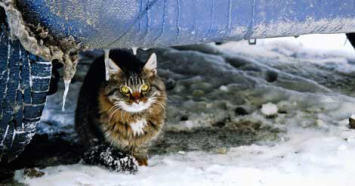
The key to winter safety is not to turn the key…
When the weather turns frightful, a nice warm place to cuddle up and drift off to sleep is the perfect remedy. For an outdoor cat, that warm spot might just be your car’s engine. In the winter months, it isn’t uncommon for veterinarians to see cats being brought in with extensive burns, degloved tails, or worse. This winter, take precautions to help cats out of this dangerous spot.
Why do cats hide in car engines?
Cats and kittens, especially strays, seek out warm shelter in the colder months. When cars are left on the streets, driveways, or even easily accessible garages, cats will gravitate to the warmth. Sitting in between the engine and hood allows them a safe break from the harsh weather. Mother cats will often stow their newborns in this location, as well.
Avoiding an Accident
If you are unable to park your car in a garage, try to get in the habit of doing a quick check for unwanted passengers before you start your car. A quick bang on the hood or beep of your horn might be enough to scare the tiny hitchhiker away. Do not start your engine prior to checking!
It’s also recommended to peek under your vehicle and on top of your tires to see if there is anything snuggled up in a spot only safe when stationary. Make sure to give them a minute to scramble out just in case they were in a deep sleep. These quick tricks could quite literally save a life.
What should you do when you find a cat in a car engine?
If you come across a cat or kitten hiding out in your engine or wheels, first and foremost try to warn them via the tips above. If they do not scatter, that could mean they are sick or injured, or worse, too young to move themselves to safety.
If possible, you can attempt to get the cat out of your car. Get a pair of thick gloves and attempt to shoo the cat away. If they are unable to move, gentle but safely remove them from the space. Local shelters and rescues are the most adept in handling these situations. Either call and see if someone can remove the animal for you or, if you have already handled the situation, call around to see if any facility has space for a potential rehab-kitten.
Additionally, if your indoor kitty gets outside and you’re unable to find them, the first place to check is under the hood of your car Fletcher, a domestic shorthair cat, fell out of the window to his house and his pet parent was unable to locate him for a whole day. Sadly, when he was finally found he had barely escaped their neighbor’s fan belt. He had a big cut across his lower belly, and a broken tibia and fibula. Fletcher’s misadventure cost his mom over $5,000. Thankfully, Embrace reimbursed almost $4,000.
If you’re looking for a safer alternative to loaning your warm engine, check out some of these cheap DIY outdoor cat homes! It could be the difference between life and death.